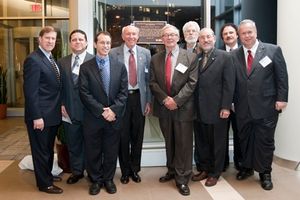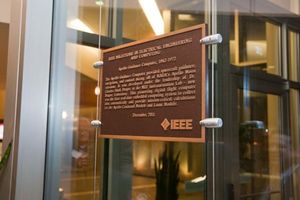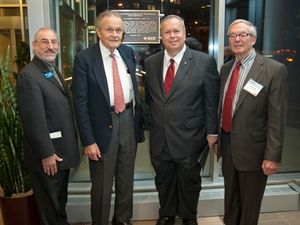Milestones:Apollo Guidance Computer, 1962-1972
Apollo Guidance Computer, 1962-1972

The Apollo Guidance Computer provided spacecraft guidance, navigation, and control during all of NASA’s Apollo Moon missions. It was developed under the leadership of Dr. Charles Stark Draper at the MIT Instrumentation Lab - now Draper Laboratory. This pioneering digital flight computer was the first real-time embedded computing system to collect data automatically and provide mission-critical calculations for the Apollo Command Module and Lunar Module.
AGC was a true pioneer: a mission-critical real-time, embedded digital computer system built using commercial integrated circuits. AGC and the associated guidance, navigation and control system components made possible the lunar rendezvous mode trajectory used by the Apollo program to put the first human beings on the moon and return them safely to earth.[1] The AGC performed flawlessly on 15 manned flights, including nine flights to the moon and six successful lunar landings. It was used for three manned Skylab missions and navigated the final Apollo spacecraft to a docking with a Russian Soyuz spacecraft in 1975.[2]
Astronauts repeatedly worked the AGC, achieving flawless moves and life-critical lunar landings. For additional information, see reference 3.[3]
ACG was one of the first computers to use integrated circuits. "During 1963, the MIT Instrumentation Lab consumed 60 percent of the integrated circuit production in the United States. By 1964, more than 100,000 IC's had been used in the Apollo program. Approximately 2000 man-years of engineering were consumed in the development of the Apollo computer hardware." [2]
Software for the AGC was developed using a mix of assembly language and an interpreted mathematical language. Processes for software validation and verification were developed, making extensive use of hardware and software simulators. By 1968, over 1400 man-years of software engineering effort had been expended, with a peak manpower level of 350 engineers. [2]
References and Further Reading
- ↑ Wikipedia, Apollo Guidance Computer, http://en.wikipedia.org/wiki/Apollo_Guidance_Computer
- ↑ Jump up to: 2.0 2.1 2.2 John Tylko, MIT and Navigating the Path to the Moon: AeroAstro Magazine Highlights, 2009 MIT http://web.mit.edu/aeroastro/news/magazine/aeroastro6/mit-apollo.html
- ↑ David A. Mindell, Digital Apollo: Human and Machine in Spaceflight. 2008 MIT Press
Additional Resources
Human Space Travel primary sources (oral histories, first-hand accounts) by people involved in the technologies of human space travel.
Letter from the site owner giving permission to place IEEE milestone plaque on the property
Proposal and Nomination
Milestone-Proposal:Apollo Guidance Computer (AGC)
Milestone-Nomination:Apollo Guidance Computer (AGC)


